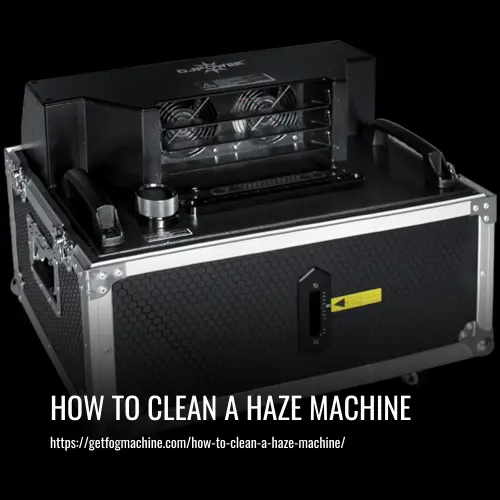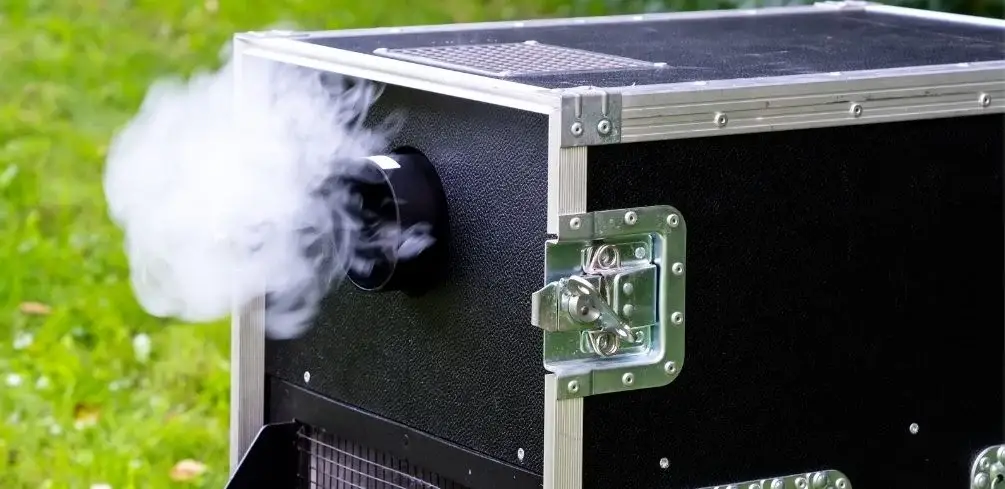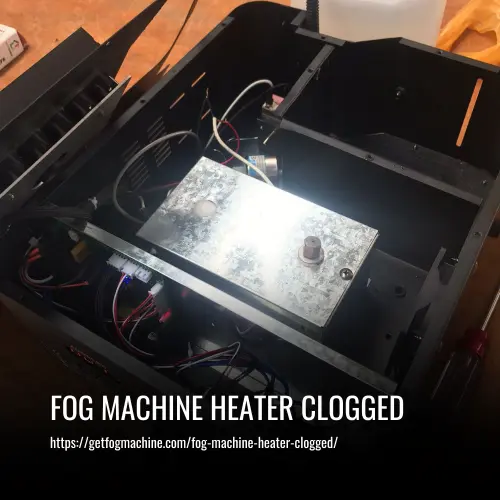Cleaning a haze machine is a crucial maintenance task to ensure optimal performance and longevity of the equipment. Proper cleaning helps remove residual haze fluid buildup and any debris that may affect the machine’s functionality and output quality.
From internal components to the external casing, a thorough cleaning regimen helps maintain a haze machine’s efficiency and ensures a consistent and desirable haze effect. Understanding the proper steps and techniques for cleaning a haze machine is essential to preserve its functionality and extend its lifespan.

How To Clean A Haze Machine
Proper cleaning of a haze machine can significantly increase its lifespan and prevent common problems like clogged output nozzles and decreased fog output. Here are the steps you need to take to clean your haze machine:
Step 1: Ingredients Needed To Clean
To begin cleaning your haze machine, you’ll need to prepare a quart of distilled water. It’s recommended to have a gallon of distilled water on hand for regular cleaning. Avoid using a vinegar mixture as it may cause damage to the machine.
Check with the manufacturer’s recommendations to ensure safe cleaning. Some manufacturers recommend using a specific fog cleaning solution, but it is not necessary for a haze machine.
Step 2: Prepare Haze Machine
To prepare your haze machine for cleaning, always ensure that the machine is turned off and unplugged. Empty the fluid tank and make sure that there is no residual fluid left. This step is important to avoid any damage or mess during the cleaning process.
Step 3: Cleaning
To clean a haze machine, fill the fluid tank with distilled water as you would do with fog juice. Close the tank’s cap before plugging it in and turning it on. Let the machine run, and it will pump the distilled water through the lines. This can help clear even a partially clogged machine. Keep the machine running and flush out the lines until the water runs clear.
During this process, the water will heat up as usual, but no fog will come out of the nozzle. This essential step helps prevent residue buildup and decreases fog output over time. Proper cleaning helps keep the entire haze machine in good working condition, leading to a longer lifespan and better performance.
Step 4: Let the Haze Machine Run
Allow the Haze machine to run until the cleaning solution in the fluid tank is nearly empty. Depending on the size and capacity of the machine, this may take an extended period of time. It is important to monitor the machine during this process to avoid any potential clogs or decreases in fog output.

Step 5: Empty Liquid Out
To properly clean a haze machine, it is important to empty the fluid tank of any remaining fog or cleaning solution. This step is crucial to ensure that the machine will function properly and produce the desired output.
Leaving any residual fluid may result in a decrease in fog output or clogging of the output nozzle. After using a cleaning solution, it is necessary to rinse the tank with distilled water to avoid any residue buildup. Once the tank is emptied and rinsed, the machine is then ready to be used again as a haze machine.
Step 6: Clean Your Fog Machine Exterior
After cleaning the inner components of your fog machine, it’s time to focus on its exterior. Use a damp cloth to wipe off any dirt or debris. If the machine has been in storage, add a few drops of dish soap to the cloth. Be cautious while cleaning the electronic parts of the fogger.
Once the exterior is clean, move on to the nozzle. Regular use can lead to buildup on the output nozzle, affecting the fog output performance. To clean, scrape off the debris and ensure the nozzle is clear for proper functioning. With the exterior and nozzle both clean, the haze fog machine is now ready for use.
Are Haze Machines Safe
Studies conducted by the American College of Allergy, Asthma, and Immunology (ACAAI) have revealed that the use of haze machines and Glycol-based smoke can pose potential health hazards, particularly among specific groups of people. The fine fog-like particles produced by haze machines may trigger respiratory problems, including asthma attacks, among individuals who are sensitive to airborne irritants.
In addition, the chemical composition of the fog emitted by haze generators may lead to eye and skin irritation, as well as headaches and dizziness. To ensure safe use, it is recommended to operate haze machines in well-ventilated areas and avoid prolonged exposure.
Operators must also regularly clean and maintain the equipment to prevent the accumulation of residual fluid or clogged output nozzles, which may lead to a decrease in fog output, damage to the machine, or even electrical hazards. Extra haze machine maintenance and proper cleaning can significantly decrease the potential for the aforementioned health risks associated with the use of haze machines.

The Importance of Cleaning Haze Machine
Haze machines are an essential tool for creating atmospheric effects in different kinds of events and occasions. As with any other equipment, cleaning haze machines should not be overlooked for it to function properly and last longer. Here are some important reasons why haze machines should be cleaned:
1. Prevents Clogging of Haze Fluid
The build-up of haze fluid residue can cause the machine’s heater and pump to clog, which can eventually lead to a decrease in output and possible damage. Regular cleaning of the haze machine fluid tank and output nozzle is essential in preventing clogging.
2. Improves Fog Output
Poor fog output over time can be an indication that a haze machine is in need of cleaning. A haze machine that has accumulated haze fluid residues can prevent the production of quality fog which is essential for creating the desired atmospheric effect.
3. Prolongs the Life of Your Haze Machine
Regular cleaning of your haze machine can help in extending the machine’s life span. Accumulated haze fluid residue can cause damage to the machine’s heater and pump over time, leading to costly repairs.
FAQs
Haze machines produce visible light beams and are commonly used in large concerts. Reel EFX DF50’s are our hazers that use a food-grade mineral oil-based fluid. Unlike typical fog machines, there is no smoke smell associated with the use of haze machines, making it ideal for prolonged use. The haze effect is quiet and long-lasting. Therefore, when properly maintained, it won’t cause any unpleasant odor.
According to the American College of Allergy, Asthma, and Immunology, prolonged exposure to the fog produced by haze machines can cause respiratory and vision-related issues. Those who do not have asthma are also at risk of developing asthma or bronchitis-like symptoms. It is crucial to maintain and clean your haze machine regularly to decrease the risk of any health problems.
Haze is generally safe to breathe, but heavy or extended exposure may cause temporary dry mouth and eyes. This can be easily remedied by drinking water. It is important to note that prolonged exposure to fog or haze liquid may cause irritation to the respiratory system. It is recommended to follow the manufacturer’s guidelines for the use and operation of the haze machine.
Haze is an atmospheric phenomenon that obscures the clarity of the sky. It is often caused by a combination of smoke, dust, and other dry particles suspended in the air. While haze may not always be visible, it can have a significant impact on human health, particularly those with respiratory problems.
It is not recommended to use water in a haze machine since it can damage the machine and decrease the output quality of the fog. Always use the recommended fog machine fluid or haze liquid to maintain a consistent output. Using water also increases the risk of clogging the machine and causing damage to its internal components. Some manufacturers offer specific cleaning solutions or fog machine cleaners to help maintain the machine’s performance.
Haze liquid can last for up to 5 years if stored in an unopened, sealed container within the temperature range of 10°C to 30°C (50°F to 86°F). However, if the fluid has been installed in a smoke machine, its lifespan will decrease to 2 years within the same temperature range. It is important to check the storage and installation dates to ensure that the haze liquid is still within its shelf life.
Haze machines can potentially worsen respiratory allergies and asthma. The solution used in some haze machines can contain glycol, glycerin, or mineral oil which may trigger breathing problems, including coughing, wheezing, chest tightness, and shortness of breath. It is important for individuals with respiratory sensitivity to avoid exposure to haze machines or speak with a medical professional before using them. Extra caution and proper ventilation should also be taken when using haze machines in public spaces.
Haze, which is a mixture of water and propylene glycol, is not typically flammable. This means that if you were to light a match and hold it near a cloud of haze, it would not result in an explosion or fire. While propylene glycol is considered a slightly combustible liquid, it can still be considered relatively safe for use near sparks or open flames. However, it is still important to exercise caution and avoid using haze machines in areas where there is a risk of fire or where the concentration of the haze is too high.
Haze is a better option than fog when it comes to filling up an entire space. Unlike fog, haze is spread evenly in the air and lasts for an extended period of time. Haze machines produce a mist that is finer and less dense compared to fog machines. Haze also enhances the atmosphere of a room, making it ideal for special events and performances. The mist from the haze machine will not block or interfere with any lighting effects or smoke detectors.
Temperature plays a crucial role in the formation of haze. As the temperature rises, the amount of water vapor in the atmosphere also increases. Haze particles are hygroscopic, meaning they can easily absorb water molecules, causing them to grow in size. These larger particles then scatter more light, leading to the appearance of haze. So, an increase in temperature can potentially increase the amount and density of haze in the air.
Conclusion
Maintaining a clean haze machine is pivotal to ensure its optimal performance and longevity. Regular cleaning procedures involve following manufacturer guidelines meticulously. This typically includes thorough cleaning after each use to remove any residual haze fluid and debris. Utilizing recommended cleaning solutions and tools, such as specialized haze machine cleaning fluid and soft cloths, aids in effectively cleaning internal components and nozzles.
Additionally, periodic deep cleaning sessions, involving disassembly and meticulous cleansing, help prevent clogs and maintain the machine’s efficiency. Proper storage in a dry, dust-free environment further safeguards the haze machine’s integrity between uses. Consistent care and adherence to cleaning protocols not only enhance the machine’s functionality but also contribute to a longer lifespan, ensuring it continues to deliver quality haze effects for various events and performances.




